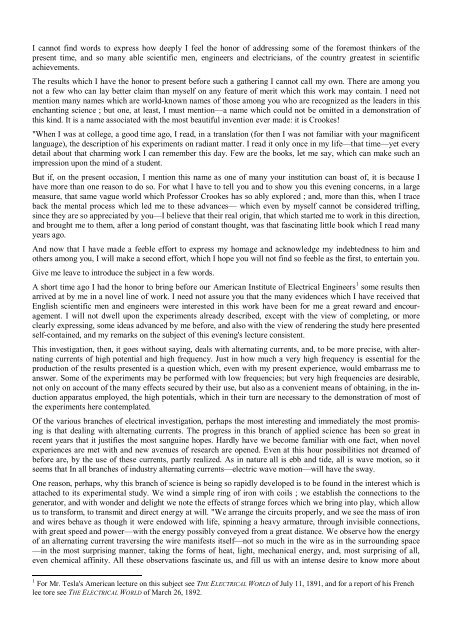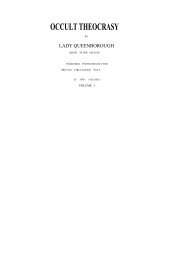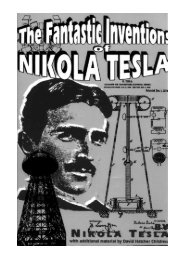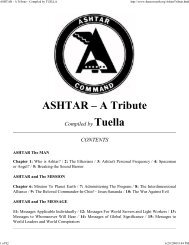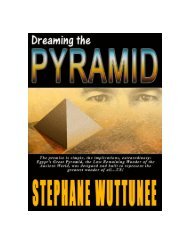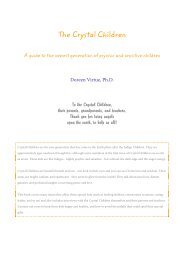the fantastic inventions of nikola tesla - Exopolitics Hong Kong
the fantastic inventions of nikola tesla - Exopolitics Hong Kong
the fantastic inventions of nikola tesla - Exopolitics Hong Kong
Create successful ePaper yourself
Turn your PDF publications into a flip-book with our unique Google optimized e-Paper software.
I cannot find words to express how deeply I feel <strong>the</strong> honor <strong>of</strong> addressing some <strong>of</strong> <strong>the</strong> foremost thinkers <strong>of</strong> <strong>the</strong><br />
present time, and so many able scientific men, engineers and electricians, <strong>of</strong> <strong>the</strong> country greatest in scientific<br />
achievements.<br />
The results which I have <strong>the</strong> honor to present before such a ga<strong>the</strong>ring I cannot call my own. There are among you<br />
not a few who can lay better claim than myself on any feature <strong>of</strong> merit which this work may contain. I need not<br />
mention many names which are world-known names <strong>of</strong> those among you who are recognized as <strong>the</strong> leaders in this<br />
enchanting science ; but one, at least, I must mention—a name which could not be omitted in a demonstration <strong>of</strong><br />
this kind. It is a name associated with <strong>the</strong> most beautiful invention ever made: it is Crookes!<br />
"When I was at college, a good time ago, I read, in a translation (for <strong>the</strong>n I was not familiar with your magnificent<br />
language), <strong>the</strong> description <strong>of</strong> his experiments on radiant matter. I read it only once in my life—that time—yet every<br />
detail about that charming work I can remember this day. Few are <strong>the</strong> books, let me say, which can make such an<br />
impression upon <strong>the</strong> mind <strong>of</strong> a student.<br />
But if, on <strong>the</strong> present occasion, I mention this name as one <strong>of</strong> many your institution can boast <strong>of</strong>, it is because I<br />
have more than one reason to do so. For what I have to tell you and to show you this evening concerns, in a large<br />
measure, that same vague world which Pr<strong>of</strong>essor Crookes has so ably explored ; and, more than this, when I trace<br />
back <strong>the</strong> mental process which led me to <strong>the</strong>se advances— which even by myself cannot be considered trifling,<br />
since <strong>the</strong>y are so appreciated by you—I believe that <strong>the</strong>ir real origin, that which started me to work in this direction,<br />
and brought me to <strong>the</strong>m, after a long period <strong>of</strong> constant thought, was that fascinating little book which I read many<br />
years ago.<br />
And now that I have made a feeble effort to express my homage and acknowledge my indebtedness to him and<br />
o<strong>the</strong>rs among you, I will make a second effort, which I hope you will not find so feeble as <strong>the</strong> first, to entertain you.<br />
Give me leave to introduce <strong>the</strong> subject in a few words.<br />
A short time ago I had <strong>the</strong> honor to bring before our American Institute <strong>of</strong> Electrical Engineers 1 some results <strong>the</strong>n<br />
arrived at by me in a novel line <strong>of</strong> work. I need not assure you that <strong>the</strong> many evidences which I have received that<br />
English scientific men and engineers were interested in this work have been for me a great reward and encouragement.<br />
I will not dwell upon <strong>the</strong> experiments already described, except with <strong>the</strong> view <strong>of</strong> completing, or more<br />
clearly expressing, some ideas advanced by me before, and also with <strong>the</strong> view <strong>of</strong> rendering <strong>the</strong> study here presented<br />
self-contained, and my remarks on <strong>the</strong> subject <strong>of</strong> this evening's lecture consistent.<br />
This investigation, <strong>the</strong>n, it goes without saying, deals with alternating currents, and, to be more precise, with alternating<br />
currents <strong>of</strong> high potential and high frequency. Just in how much a very high frequency is essential for <strong>the</strong><br />
production <strong>of</strong> <strong>the</strong> results presented is a question which, even with my present experience, would embarrass me to<br />
answer. Some <strong>of</strong> <strong>the</strong> experiments may be performed with low frequencies; but very high frequencies are desirable,<br />
not only on account <strong>of</strong> <strong>the</strong> many effects secured by <strong>the</strong>ir use, but also as a convenient means <strong>of</strong> obtaining, in <strong>the</strong> induction<br />
apparatus employed, <strong>the</strong> high potentials, which in <strong>the</strong>ir turn are necessary to <strong>the</strong> demonstration <strong>of</strong> most <strong>of</strong><br />
<strong>the</strong> experiments here contemplated.<br />
Of <strong>the</strong> various branches <strong>of</strong> electrical investigation, perhaps <strong>the</strong> most interesting and immediately <strong>the</strong> most promising<br />
is that dealing with alternating currents. The progress in this branch <strong>of</strong> applied science has been so great in<br />
recent years that it justifies <strong>the</strong> most sanguine hopes. Hardly have we become familiar with one fact, when novel<br />
experiences are met with and new avenues <strong>of</strong> research are opened. Even at this hour possibilities not dreamed <strong>of</strong><br />
before are, by <strong>the</strong> use <strong>of</strong> <strong>the</strong>se currents, partly realized. As in nature all is ebb and tide, all is wave motion, so it<br />
seems that In all branches <strong>of</strong> industry alternating currents—electric wave motion—will have <strong>the</strong> sway.<br />
One reason, perhaps, why this branch <strong>of</strong> science is being so rapidly developed is to be found in <strong>the</strong> interest which is<br />
attached to its experimental study. We wind a simple ring <strong>of</strong> iron with coils ; we establish <strong>the</strong> connections to <strong>the</strong><br />
generator, and with wonder and delight we note <strong>the</strong> effects <strong>of</strong> strange forces which we bring into play, which allow<br />
us to transform, to transmit and direct energy at will. "We arrange <strong>the</strong> circuits properly, and we see <strong>the</strong> mass <strong>of</strong> iron<br />
and wires behave as though it were endowed with life, spinning a heavy armature, through invisible connections,<br />
with great speed and power—with <strong>the</strong> energy possibly conveyed from a great distance. We observe how <strong>the</strong> energy<br />
<strong>of</strong> an alternating current traversing <strong>the</strong> wire manifests itself—not so much in <strong>the</strong> wire as in <strong>the</strong> surrounding space<br />
—in <strong>the</strong> most surprising manner, taking <strong>the</strong> forms <strong>of</strong> heat, light, mechanical energy, and, most surprising <strong>of</strong> all,<br />
even chemical affinity. All <strong>the</strong>se observations fascinate us, and fill us with an intense desire to know more about<br />
1 For Mr. Tesla's American lecture on this subject see THE ELECTRICAL WORLD <strong>of</strong> July 11, 1891, and for a report <strong>of</strong> his French<br />
lee tore see THE ELECTRICAL WORLD <strong>of</strong> March 26, 1892.


